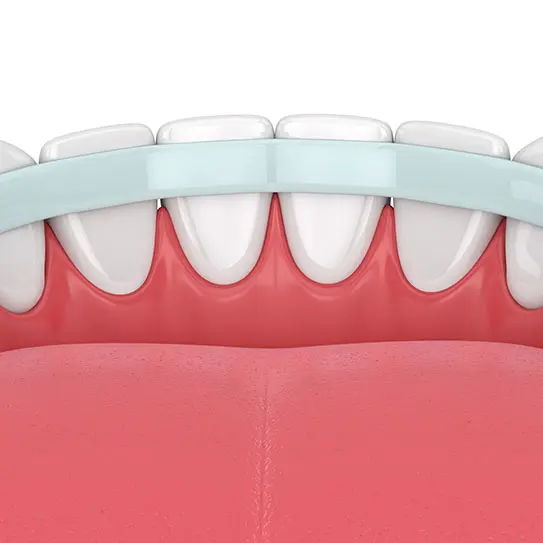
Stabilize Your Smile, Save Your Tooth
Discovering that you have a loose tooth as an adult can be alarming — but it’s not necessarily the end of the road for that tooth. One treatment option that may help preserve and stabilize loose teeth is the use of dental splints. If you’ve been wondering whether dental splints for loose teeth could be the right solution for you, let’s look at how they work, who they help, and what to expect from treatment.
At Sheila L. Brush, DDS, PC, we provide effective, minimally invasive options like periodontal splints to help our patients regain function and comfort while preserving their natural teeth whenever possible.
Why Teeth Become Loose
Loose teeth in adults are usually the result of one of the following:
- Advanced gum disease (periodontitis): As gum tissue and supporting bone break down, teeth may become mobile.
- Trauma or injury: A blow to the face or mouth can loosen one or more teeth.
- Bruxism (teeth grinding): Constant grinding can gradually weaken the ligaments supporting the teeth.
- Orthodontic movement or bite misalignment: Shifting forces can place uneven pressure on certain teeth.
Regardless of the cause, it’s important to address a loose tooth quickly. In many cases, dental splints for loose teeth can offer a non-surgical, tooth-saving solution.
What Are Dental Splints?
Dental splints, sometimes called periodontal splints, are appliances used to stabilize teeth that have become loose due to loss of bone or ligament support. A dental splint works by bonding the loose tooth to one or more neighboring teeth, distributing biting forces more evenly and giving the affected tooth a chance to heal. There are two main types of splints:
- Temporary splints: Usually made with composite resin and wire or mesh, these are bonded to the back of teeth and used short-term to stabilize a tooth after trauma or during healing.
- Permanent (or long-term) splints: These may involve a more durable material or the integration of crowns, and are used when chronic instability is present.
At Sheila L. Brush, DDS, PC, we evaluate your specific condition to determine whether temporary or long-term periodontal splints are the best choice for your case.
Are You a Good Candidate for Dental Splints?
You may be a candidate for dental splints for loose teeth if:
- You have one or more teeth that are mobile but still structurally sound
- The mobility is caused by gum disease, bruxism, trauma, or minor bite issues
- You’re in otherwise good oral health, or willing to address underlying conditions
- You want to avoid tooth extraction or more invasive procedures if possible
During your consultation, we’ll assess the health of your gums, supporting bone, and surrounding teeth. If gum disease is present, it must be treated and controlled first. Splinting is most successful when paired with a solid periodontal maintenance plan.
Benefits of Periodontal Splints
- Tooth Preservation: One of the greatest benefits of using periodontal splints is the ability to preserve your natural teeth. In many cases, they help delay or avoid the need for extractions.
- Improved Comfort and Function: A loose tooth can make eating and speaking difficult. Splinting stabilizes the tooth, restoring comfort and allowing you to bite and chew more normally.
- Better Oral Hygiene: By anchoring the tooth and restoring some structure, splints can make it easier to maintain good oral hygiene and prevent future gum problems.
- Non-Surgical Option: Splinting is a conservative, minimally invasive treatment that avoids the recovery time and higher costs associated with surgical alternatives.
What to Expect During the Procedure
If you’re a candidate for dental splints for loose teeth, the procedure is relatively simple. Here’s what you can expect:
- Evaluation: We’ll examine your teeth, gums, and bite to determine if splinting is appropriate.
- Cleaning and Preparation: The teeth involved are thoroughly cleaned and prepared.
- Application: A bonding agent and splinting material (usually wire, mesh, or resin) are used to join the loose tooth to neighboring stable teeth.
- Polishing and Finishing: The splint is polished to ensure it’s smooth and comfortable in your bite.
The process usually takes just one visit, and most patients experience immediate relief and stabilization.
Caring for Splinted Teeth
After you receive periodontal splints, it’s important to:
- Maintain excellent oral hygiene around the splint
- Avoid hard or sticky foods that can dislodge or damage the splint
- Keep up with regular dental cleanings and checkups
- Use a nightguard if you grind your teeth at night
Proper maintenance helps prolong the life of the splint and supports the long-term health of the affected teeth.
Find Out if Dental Splints Are Right for You
If you’re dealing with loose teeth, you may not need an extraction or a complex restorative procedure. In many cases, dental splints for loose teeth offer a simple and effective way to restore stability and save your natural teeth. At Sheila L. Brush, DDS, PC, we’re proud to provide periodontal splints as part of our commitment to conservative, personalized care.
Think you might be a candidate for splinting? Schedule an appointment today to learn more about your options for dental splints and take the first step toward a stronger, healthier smile.
